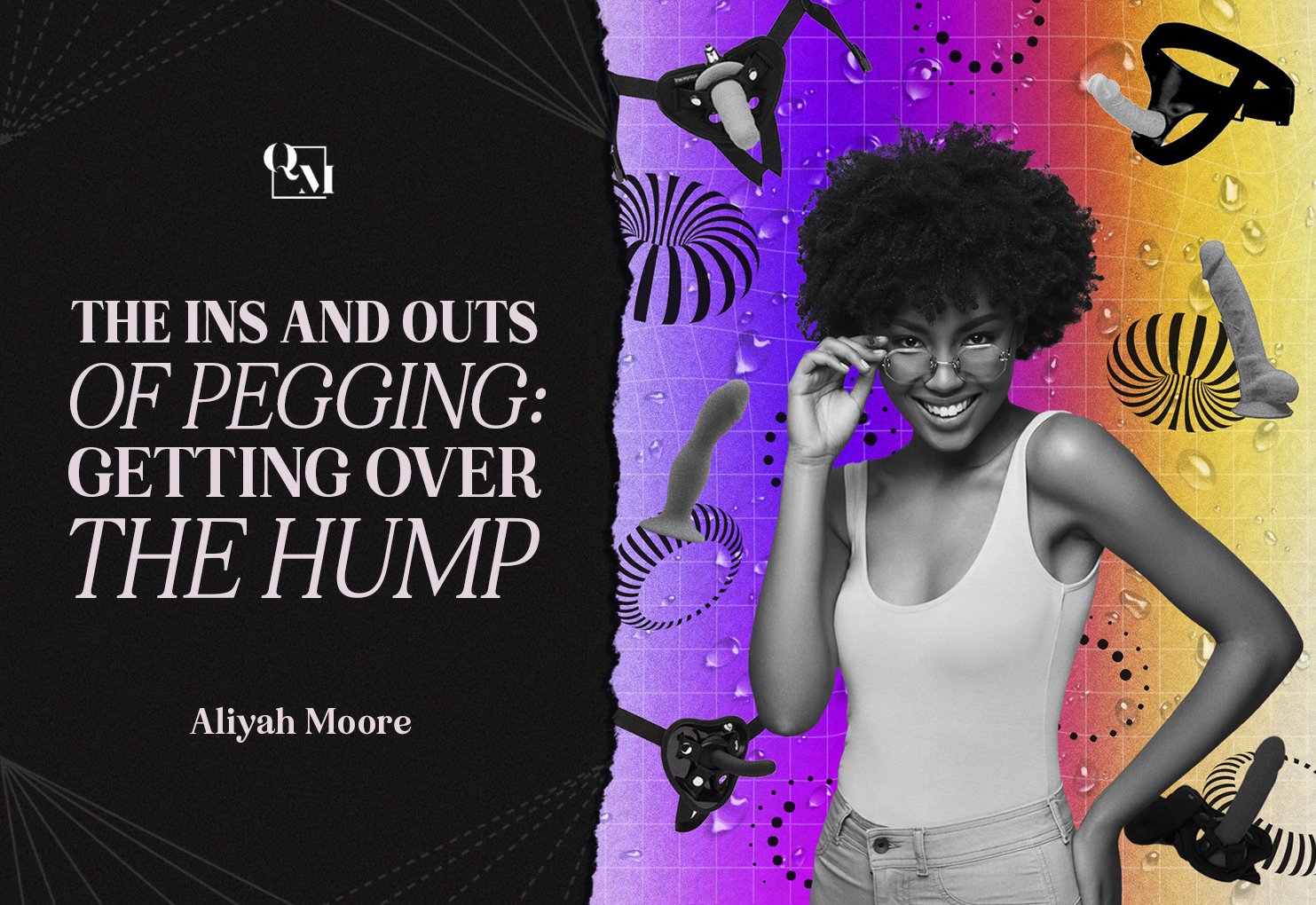The Ins and Outs of Pegging: Getting Over the Hump
In 2001, sex columnist Dan Savage launched an internet poll that immortalized the word “peg” as the de facto term for a female anally penetrating a male with a strap-on dildo (the other candidates were “bob” and “punt”). Since then, the practice has grown in popularity and expanded to mean anyone anally penetrating their partner with a strap-on. In fact, 16% of sexually active adults have tried pegging, and a whopping 60% of men have fantasized about it. For those who take the plunge, it can be a source of pure bliss. From the ecstasy of anal stimulation to the opportunity to play with dominance, submission, and sexual roles, pegging gives people the chance to have more sexual satisfaction than biology alone would ordinarily allow and to experience something outside their standard sexual practice. Pegging can nevertheless seem more than a little intimidating, especially to men, including bi men, even if it interests them. But, as we’ll explore, it needn’t be that way.
Despite increasing interest, there are stigmas around pegging that often go beyond those of other kinks. Sexual traditionalists and social conservatives may disapprove of things like BDSM or roleplay, for example, but they don’t typically equate them with being “less of a man.” Guys who get pegged, on the other hand, may be seen as — or more importantly, feel themselves to be — less masculine, more effeminate, or less respected. Pegging can, for some men, seem to open the door to insecurities about their sexual orientation, masculinity, ability to satisfy their partner, inexperience with anal sex, and even their self-conception. It can also evoke anxieties around confirming negative stereotypes. Let’s defang these concerns in turn.
Incredible progress has been made in the social acceptance of LGBT people and in more open-minded attitudes about sexuality and gender roles. As a result, the number of people who now feel comfortable coming out as bi has soared. An even greater number of folks admit to having same-sex attractions, with more than half of straight-identified young people saying they’d be open to same-sex behavior. Despite this, sexist ideas about the man in any opposite-sex relationship having to be the dominant one and penetration as a sign of said dominance still run strong. For this reason, some men might feel that being pegged by a female partner reverses their sense of dominance and that they no longer “wear the pants” in the relationship. In some cases, it may even lead them to become confused about their sexuality. Using a strap-on for penetration also requires trust in the partner doing the penetrating and a willingness to cede control on the part of the partner getting penetrated, two dynamics some men may be unaccustomed to. Pegging can seem like a terrifying leap of faith, even to men who have a sexual interest in it.
Pegging need not, however, have anything to do with submission, dominance, gender roles, or sexuality. Many enjoy the practice for the pure physical pleasure, the novelty, and the wider range of bedroom opportunities it opens up. Others find the transgressiveness and power play aspect exciting. Dominance and submission are highly subjective and personal aspects of sexuality. In some female-female relationships, dominance and submission don't play a large sexual role, and pegging can add those extra flavors to sex. At their core, anxieties around dominance and submission have to do with how people view themselves. We all have a conception of who we are and into which categories we fit, and we tend to feel uncomfortable when our self-image is thrown into doubt; however silly the basis of that doubt might be. Recognizing that pegging is a simple sexual act, no different from any other, and attached only to the baggage we give it, is the first step to addressing any anxieties we might have.
For bi folks, pegging can invoke a different set of stigmas. It’s no secret that bi people are often perceived — both inside and outside the LGBT community — as gay people who aren’t “out” yet. These clichés lend themselves to false assumptions that bi men who get pegged are really only interested in gay sex or that bi women who peg actually have an unmet need to take a traditionally “male” role in a lesbian relationship. By engaging in pegging, some bi people might feel that they are feeding into these ridiculous stereotypes. Openly bi men in particular face a degree of prejudice in the dating market from straight women and sometimes develop the habit of code-switching and playing up their masculine attributes in response. Such men might therefore fear that broaching the topic of pegging with female partners could be a major turn-off. The weight of judgment, real or perceived, can stand in the way of healthy and pleasurable sexual exploration.
What are some ways we can overcome this stigma? Of course, no one needs to broadcast their sex lives to the world. But whether or not anyone will know that your partner pegs you (or vice versa), breaking taboos can still produce some level of insecurity and anxiety that can make you uncomfortable with sexual experimentation, even if it’s what you want. Knowing how others would feel about your actions can be as sexually stifling as if they did know. Being mindful of your own feelings is the first step to getting comfortable with pegging. Open and honest communication with your partner is the second.
A good place to start is by asking your partner if they’re worried about what other people might think. Are they worried about the opinions of neighbors, coworkers, bosses, friends, or family? Even if it stays secret, do those judgments carry weight with them? Ask your partner if pegging would make them feel submissive or less equal. Would they be willing to experiment with that? Would you use safewords or other strategies to make them feel comfortable? This is less about social stigma (though that’s also a factor) and more about your partner’s unique self-conception. Would they feel less or more like themselves if they tried pegging? Sexual exploration, the kind that is satisfying and sustainable, isn’t about adding anxiety to your life; rather, it’s about releasing that anxiety to experience pleasure and connection. This may mean that one or both of you need to deal with the fear and insecurity first, which makes the conversation about pegging different from many other sexual communication topics.
Likewise, anal sex isn’t something to make assumptions about, regardless of a partner’s sexual orientation. Some people may assume that bi men are necessarily more experienced with anal sex, but it’s still important to have a conversation about anal before experimenting. From pain to medical conditions to sexual abuse, there are a hundred reasons someone might be hesitant about anal penetration, which is why communicating with your partner and listening to their concerns is key. Anal sex, particularly if you’re a novice, can involve some level of pain in the beginning. This usually means your experience won’t be perfect the first time you try it, but with sensitivity to your partner’s experience and a little persistence, it will improve. It’s also worth trying different lubes, positions, and toys to find what you like. If you aren’t already familiar, consult an anal guide before you get started.
Another hurdle to pegging may arise in relationships where one partner is bisexual and the other is not: a sense of inadequacy in the mind of the straight/gay partner. Pegging might make them wonder if they are “enough” or if their bi partner really yearns for a partner with genitals the straight/gay partner doesn’t have. These feelings are partly a product of growing up in a culture where bisexuality and bi people may have had little or no visibility. It’s a good idea to talk about relationship insecurities, whether they come up naturally or not. If you are bi, this means ensuring your partner not only that you want to experience this kind of sex, but that you want to experience it with them.
This may feel like a lot to worry about, but pegging can be a big step — especially for people who aren’t accustomed to sexual experimentation. Pegging is often treated as a joke or a symbol of emasculation. And when that prevailing sentiment collides with social pressures on men or with the unique dynamics of bi relationships, it can feel overwhelming. The only way to shrink the anxiety is to talk and communicate. BDSM used to be so taboo that it was considered a mental disorder, but after years of open dialog, it’s practically become a mainstream sexual practice. If you secretly (or not-so-secretly) would love to try pegging, talk it out with your partner. Soon enough, you’ll be happily taking it both ways.
Published Oct 13, 2023








